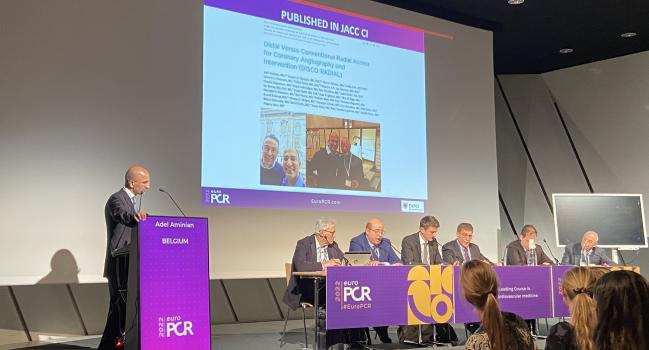Distal Radial Access Doesn’t Lower Risk of Occlusion: DISCO RADIAL
Although it wasn’t superior to conventional radial access, distal radial was safe and might be a useful option in select cases.

PARIS, France—When it comes to reducing the risk of radial artery occlusion (RAO), there is no significant advantage to using the relatively novel distal radial approach over conventional radial access, according to results of a new randomized trial.
Both techniques resulted in very low rates of RAO—less than 1.0%—and affirm the role of conventional radial vascular access for coronary angiography and PCI, say investigators. Given the low risk of RAO with distal radial access, though, this technique could be a “valid alternative,” although physicians must balance its benefits against its more demanding arterial puncture, they say.
“Everything in interventional cardiology starts with vascular access and finishes with vascular access,” said lead investigator Adel Aminian, MD (Centre Hospitalier Universitaire de Charleroi, Charleroi, Belgium), explaining the rationale for the DISCO RADIAL trial to the media. While the radial artery is the first choice for vascular access owing to its safety—and is endorsed by both the US and European clinical guidelines—it’s not without some risks, he said.
“Occlusion of the radial artery is the most common complication after the procedure, and it has an impact because it precludes the use of the same radial artery for future procedures or as a conduit for CABG,” he said. “Decreasing the rate of occlusion should be central to all radial programs.”
The rate of RAO after radial interventions in the real world is relatively high, said Aminian, noting that some estimates suggest it may occur in as many as 10% of cases. However, there is wide variability in the use of best practices to prevent RAO, making it difficult to assess the true incidence of occlusion after transradial interventions.
Distal radial access—where the radial artery is punctured distal to the superficial palmar arch—has emerged as an alternative to reduce the risk of occlusion. Single-center studies have suggested it’s superior to the conventional approach, said Aminian, but these studies were hampered by the high rate of RAO with transradial access, which made comparisons between two techniques difficult.
Best Practices for Reducing RAO
Presented yesterday as a late-breaking clinical trial at EuroPCR 2022 and published simultaneously in JACC: Cardiovascular Interventions, the DISCO RADIAL study randomized 1,307 patients with clinical indications for a percutaneous coronary procedure using a 6-Fr Slender sheath (Terumo Europe) to conventional radial or distal radial access. The primary endpoint was the incidence of forearm RAO assessed by vascular ultrasound at discharge.
Decreasing the rate of occlusion should be central to all radial programs. Adel Aminian
For the patients treated with conventional radial access, hospital staff followed the PROPHET protocol to achieve patent hemostasis. In brief, after applying the air-filled compression device and removing the sheath, hemostatic pressure was set to a level just enough to maintain hemostasis without harming radial artery patency as assessed by the reverse Barbeau test. With distal radial access, hemostasis was achieved according to hospital practice.
At discharge, the rate of RAO was 0.91% for those randomized to conventional radial access and 0.31% among those treated with distal radial access (P = 0.29).
Crossover was higher in the distal radial access arm—7.4% of operators switched to the conventional radial approach—and this highlights the technical demands of the procedure, even amongst this group of experienced radial operators, said Aminian. The duration of the intervention wasn’t any longer with distal radial access, but the rate of radial artery spasm was higher (5.4% vs 2.7%; P < 0.015). The overall time to hemostasis was longer with conventional radial access (median 180 vs 153 minutes; P < 0.001).
“It’s definitely a more demanding, challenging puncture,” Aminian told TCTMD. “The trajectory of the distal radial artery is less predictable than the forearm radial artery. It has a curvilinear course, so it’s difficult sometimes to puncture it.”
With both techniques, hospital staff adhered to best RAO-prevention practices—adequate anticoagulation, effective spasmolytic therapy, and use of the slender sheath, as well as using experienced operators to perform the procedures—and this contributed to the very low rates observed in this trial, said Aminian. In fact, the DISCO RADIAL researchers say this trial establishes a new benchmark for RAO rates after conventional transradial access.
In the RATATOUILLE study, also published yesterday in JACC: Cardiovascular Interventions, investigators showed that use of distal radial access was safe, reporting that it wasn’t associated in any functional hand impairment in 313 patients who underwent detailed testing after undergoing distal radial access PCI/angiography.
Less Than 1% RAO—Can’t Get Much Better Than That
Sanjit Jolly, MD (Population Health Research Institute/McMaster University, Canada), who has been at the forefront of research establishing the advantages of radial access over the femoral approach, said the distal radial technique was pioneered for left-sided interventions, which entail an awkward reach across the patient.
One of the issues with RAO is that operators don’t often know how frequently it occurs in their practice. “Unless you measure it, most radial artery occlusion is silent,” Jolly told TCTMD. “Patients go home and the only time you find out about it is when they come back for a repeat procedure a year later or 5 years later and you realize the radial is occluded. We don’t have good real-life estimates.”
Jolly said that rate of RAO in DISCO RADIAL was extremely low, suggesting that if physicians adopt an evidence-based strategy for preventing it, rates can be slashed below 1%. “Really, I don’t think you can do much better than that,” he said. “If you use patent hemostasis, heparin, and expert operators, radial artery occlusion, at least within this trial, was extremely uncommon.”
Overall, Jolly said both radial and distal radial access are reasonable approaches, but “conventional radial access is likely to remain the procedure of choice with distal radial more likely to be used for left radial procedures due to ease of access.”
In an editorial accompanying the publication, Grigorios Tsigkas, MD, PhD, Anastasios Apostolos, MD, and Periklis Davlouros, MD (all University of Patras, Greece), write that RAO has been labeled the Achilles’ heel of conventional radial access, but DISCO RADIAL shows that with evidence-based best practices, the risk can be minimized. In addition, use of the distal radial approach can complement conventional access as a means to reduce the risk further.
Two more forthcoming clinical trials—RESERVE evaluating distal radial access for primary PCI in STEMI patients and a similar study from South Korean researchers— help shed even more light on the potential role of distal radial access, say the editorialists.
Michael O’Riordan is the Managing Editor for TCTMD. He completed his undergraduate degrees at Queen’s University in Kingston, ON, and…
Read Full BioSources
Aminian A, Sgueglia GA, Wiemer M, et al. Distal versus conventional radial access for coronary angiography and intervention (DISCO RADIAL).J Am Coll Cardiol Intv. 2022;Epub ahead of print.
Sgueglia GA, Hassan A, Harb S, et al. International hand function study following distal radial access: the RATATOUILLE study. J Am Coll Cardiol Intv. 2022;Epub ahead of print.
Banerjee S, Walker M. Distal radial artery access for coronary catheterization: a curated approach. J Am Coll Cardiol Intv. 2022;Epub ahead of print.
Disclosures
- DISCO RADIAL is sponsored by Terumo Europe.
- Aminian reports consulting and lecture fees from Terumo Europe.
- Banerjee reports honoraria from Medtronic and GE and reports institutional grant support from Chiesi.





Comments